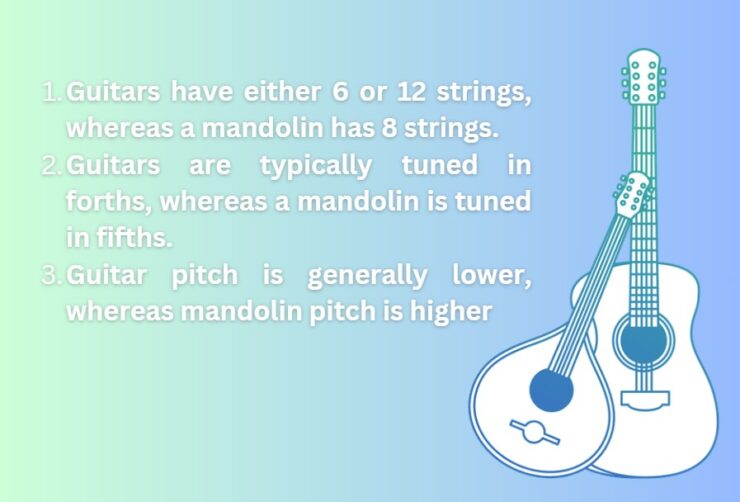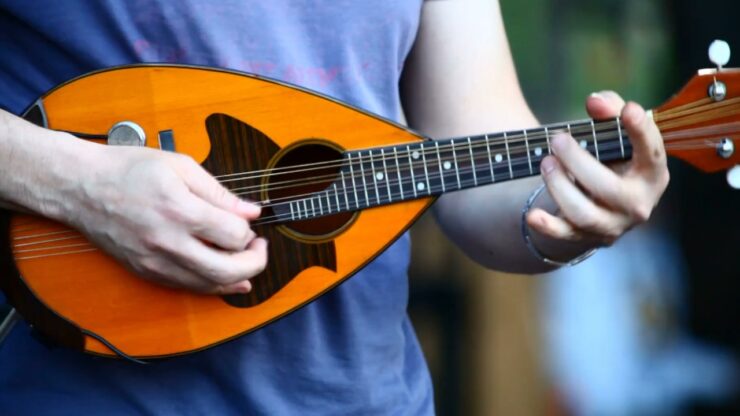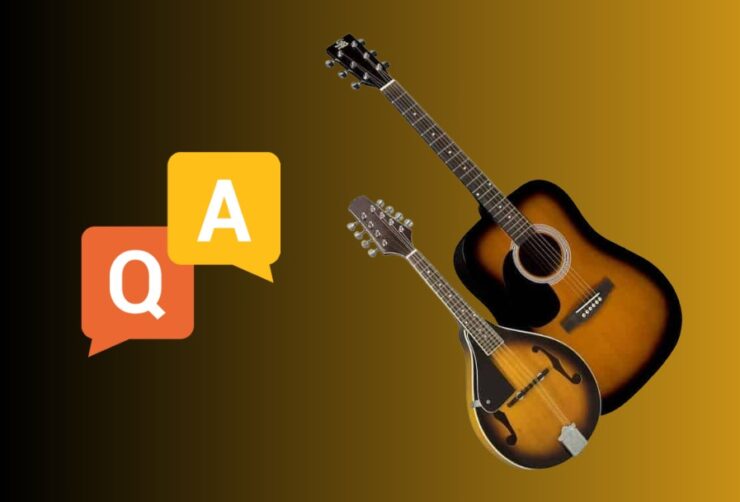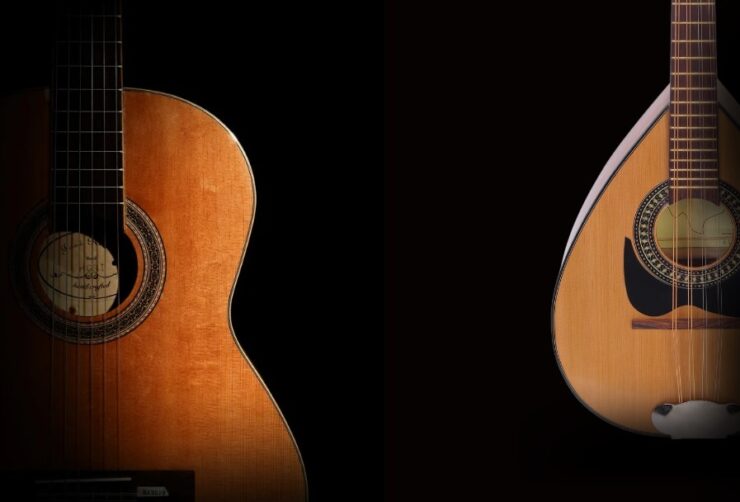Welcome, music enthusiasts! If you’ve ever thought about picking up a stringed instrument, you’ve likely considered the mandolin and guitar. These two popular instruments both have their own unique charm, but which one is easiest to learn? In this comprehensive guide, we’ll delve deep into the world of mandolins and guitars. We’ll compare their physical attributes, learning curves, versatility, and much more to help you make an informed decision. So, let’s begin our melodic journey to find out which of these instruments might be your perfect match!
Comparing the Basics

Mandolins are smaller than guitars, with their body length measuring around 10-14 inches, while guitars have a body length of approximately 18-20 inches. Mandolins feature a teardrop-shaped body and a distinctive scroll, giving them a unique appearance. Guitars, on the other hand, come in various shapes, like dreadnought, parlor, and concert. The smaller size of the mandolin makes it easier to hold and transport. However, the guitar’s larger size provides more resonance and a fuller sound.
Strings and Tuning
The mandolin has eight strings, arranged in four pairs or “courses,” with each pair tuned to the same note. Standard mandolin tuning is G-D-A-E (from the lowest to the highest string). Guitars typically have six strings, with standard tuning being E-A-D-G-B-E. While the mandolin has more strings, they are closer together, which can make fretting and picking slightly more challenging for beginners. The wider spacing of guitar strings allows for more comfortable fingering and strumming. When it comes to tuning a guitar, beginners often find it helpful to use a reference pitch from another instrument, such as a piano, to ensure accurate tuning.
Learning Curve
Mandolin chords tend to be simpler than guitar chords, as there are fewer strings to manage. Additionally, the mandolin’s smaller fretboard allows for easier access to notes, making it possible to play chords and scales with minimal hand movement. However, the closeness of the strings can make precise finger placement a challenge. Guitar chords can be more complex, with barre chords being particularly challenging for beginners. Nonetheless, the larger fretboard and wider string spacing make accurate finger placement easier.
Techniques and Difficulty
Mandolins are primarily played using a pick, with techniques like tremolo (fast, repeated picking) and cross-picking (alternate picking across strings). These techniques can be challenging for beginners but become more manageable with practice. Guitars can be played with a pick, fingerstyle, or a combination of both. This versatility allows beginners to experiment and find a playing style that suits them best. Techniques like fingerpicking, strumming, and palm muting offer a diverse range of possibilities, making the guitar a versatile instrument for various genres.
Strumming Techniques for the Mandolin and Guitar
Strumming techniques are an essential part of playing both the mandolin and guitar. The strumming technique involves using your fingers or a pick to strike the strings in a rhythmic pattern to create chords or melodies. For beginners, it can be challenging to get the timing and rhythm right, but with practice, it becomes more natural. On the guitar, the most basic strumming technique is the downstroke. This involves striking all the strings with a downward motion, creating a chord. Once you have mastered the downstroke, you can start to incorporate upstrokes and alternate between downstrokes and upstrokes to create more complex rhythms.
On the mandolin, the basic strumming technique is the chop. This involves using the plectrum to hit the strings in a downward motion, creating a percussive sound. The chop is used to create rhythm and is often used in bluegrass and folk music. In addition to the chop, mandolin players can also use tremolo, which involves rapidly alternating between two notes using the same finger. Tremolo is often used in classical mandolin music. When it comes to strumming, it’s important to find a technique that works best for you and the style of music you want to play. Practice is essential to master strumming techniques, and it’s recommended to start with simple patterns before moving on to more complex rhythms.
Picking Techniques for the Mandolin and Guitar

Picking techniques are an important aspect of playing both the mandolin and guitar. Unlike strumming, which involves hitting all strings at once, picking involves using individual fingers or a pick to pluck or strike each string separately. Picking is a versatile technique that allows for greater precision and control, enabling players to create intricate melodies and solos.
On the guitar, the most basic picking technique is alternate picking, which involves using a pick to strike each string alternately in an up-down motion. Fingerpicking, on the other hand, involves using individual fingers to pluck the strings, enabling players to create complex fingerstyle arrangements. On the mandolin, the most common picking technique is tremolo, which involves rapidly alternating between two notes using the same finger.
Tremolo is used to create a rapid, rolling sound and is a staple of bluegrass and classical mandolin music. Mandolin players also use cross-picking, which involves using a pick to strike multiple strings at once in a crosswise motion. It’s essential to start with simple picking patterns and gradually build up speed and complexity. With practice and patience, anyone can become proficient at picking on the mandolin and guitar.
Versatility and Genres
The mandolin has a bright, crisp sound that lends itself well to various genres, including bluegrass, folk, classical, and even jazz. Its unique timbre can add depth and character to any ensemble. However, the mandolin is less common in popular music compared to the guitar.
The guitar is one of the most versatile instruments, with its rich sound and adaptability to various playing techniques. It’s suitable for almost every genre, from rock, pop, blues, and country to jazz, classical, and flamenco. With its extensive range of styles, the guitar offers an almost limitless opportunity for self-expression and creativity.
Availability of Resources

Though the mandolin community is smaller than the guitar community, there are still plenty of resources available for beginners. Online tutorials, instructional books, and dedicated forums provide invaluable guidance and support. The mandolin’s niche appeal fosters a close-knit community where players are often eager to share their knowledge and expertise.
The guitar’s popularity means that there is an abundance of learning resources available. From countless YouTube tutorials and online courses to instructional books and dedicated websites, beginners can easily access materials for every skill level and style. The guitar community is vast, offering endless opportunities to connect with fellow players, join ensembles, and attend workshops.
Price and Accessibility
Mandolins are generally less expensive than guitars, with beginner models starting at around $100. However, higher-quality mandolins can be significantly more costly. As with any instrument, investing in a well-made mandolin will provide a better playing experience and help you progress more easily.
Guitars come in a wide range of prices, with beginner models available for as little as $100. More advanced models can cost several thousand dollars, but there are many mid-range options that offer excellent value for money. The guitar’s popularity also means that it’s often easy to find second-hand instruments at a reduced price.
FAQs

Can I transition from learning the guitar to the mandolin, or vice versa?
Yes, many skills are transferable between the two instruments, such as chord shapes and scales. However, each instrument has unique techniques and challenges, so dedicated practice is necessary when transitioning.
Which instrument is more comfortable to hold and transport?
The mandolin is smaller and lighter, making it easier to hold and transport. Guitars are larger and heavier but provide more resonance and a fuller sound.
Are there different types of mandolins and guitars?
Yes, both instruments come in various types. Mandolins are available in styles like the A-style, F-style, and bowl-back. Guitars come in different shapes, like dreadnought, parlor, and concert, and they can be either acoustic or electric.
Is it possible to play both instruments simultaneously or switch between them in performance?
Yes, some musicians can play both instruments simultaneously using a technique called “tapping” or by employing unique setups. However, this requires advanced skills and practice. More commonly, musicians switch between the instruments during a performance, showcasing their versatility and ability to adapt to different musical styles.
How do I choose between learning the mandolin or the guitar?
Choosing between the mandolin and the guitar depends on your personal preferences, learning style, and musical interests. Consider factors like size, chord complexity, playing techniques, versatility, and the genres you’re interested in. It may be helpful to try playing both instruments or attending workshops and lessons to get a feel for which instrument resonates with you the most. Ultimately, the best choice is the one that aligns with your passion and goals.
Conclusion
Both the mandolin and guitar have unique characteristics that make them appealing to aspiring musicians. When it comes to which is easiest to learn, the answer depends on your personal preferences and learning style. The mandolin has a simpler chord structure, a smaller fretboard, and a more compact size, which can make it an attractive choice for beginners. However, it’s close string spacing and specialized techniques may present challenges.
The guitar offers a more extensive range of playing techniques and is suitable for a wide variety of genres. It has a steeper learning curve when it comes to mastering chords, but its versatility and abundance of learning resources make it a popular choice for beginners. Ultimately, the best instrument for you is the one that resonates with your musical interests and aspirations. Both the mandolin and guitar have much to offer, and each can provide a lifetime of musical enjoyment. So, take the time to explore each instrument, and let your passion guide you toward the perfect choice. Happy playing!

